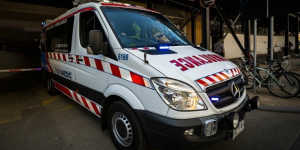A map of the restructure obtained by Fairfax Media indicates a new hub-and-spokes model would revolve around 12"superstations"where staff and vehicles will be based,with each one supported by between two and six"paramedic response points".

Several ambulance stations will be downgraded to 'stand by points'.Fairfax Media
It would involve the construction of at least 20 new sites in addition to the hubs.
A NSW Ambulance spokesman said the map was one of the many prepared to analyses different station configurations.
"It is not an up to date map,and more importantly it does not show the current superstation plan,"he said.
The Health Services Union[HSU] is concerned that the proliferation of sites without a corresponding increase in paramedics will only stretch existing staff across vast distances.
The NSW Government has approved $150 million to build the first five hubs and construction has started at Bankstown,Blacktown,Kogarah and Liverpool,with Penrith soon to follow.
The map names Wentworthville,Rockdale and Summer Hill as"confirmed"hub locations,and Kirrawee,Naremburn,Waverley and central Sydney as"proposed"sites.
Existing stations would be downgraded to paramedic response points - or"standby points"- at Tregear,Colyton,Auburn,Macquarie Fields,Fairfield,Menai,Engadine,Carringbah,Marrickville,Drummoyne,Concord,Paddington,Bondi and Maroubra.
NSW Ambulance said in a statement that the hubs will be used as bases for each area's management team,restocking and cleaning vehicles and training exercises.
The five funded superstations were identified in areas that had either reached capacity or where the existing stations were not ideally located to meet the needs of the community.
"Superstations and paramedic response points will be operational 24 hours a day,7 days a week,as is the case with existing metropolitan Sydney stations,"the statement said.
"In areas where superstations are built,paramedics will start and end their shift at a superstation;however,they will use any paramedic response point throughout their shift depending on where they completed their last job."
But HSU councillor and paramedic Greg Bruce said requiring staff to start their shifts in the hubs meant they would take longer to respond to emergencies in the suburbs,with stations such as Tregear and Colyton already struggling to meet the eight minute target.
In the last two weeks,a St Clair patient with chest pain waited 15 minutes for an ambulance to arrive,an Eastern Creek patient with urgent trauma waited Clair patient having an asthma attack waited 14 minutes.
Under the proposed structure patients would be serviced by the hub in Penrith.
If new stations were built,they needed to be adequately staffed,Mr Bruce said.
"They want to take staff away from existing stations and put them in another location and it's madness,"he said.
"We've been calling for this for ages,for additional locations. We desperately need it to service the public and get the response times down,but it's got to come with additional staffing."
A similar model in the East Midlands in Britain was abandoned after protests from staff and patients,who were concerned about the loss of local stations without proof that the plan would improve response times.
NSW Ambulance said it had conducted"operational research"for more than a decade,and all the evidence suggested a clear patient and service benefit.
An Auditor-General's report published last year indicated that for the most urgent cases.